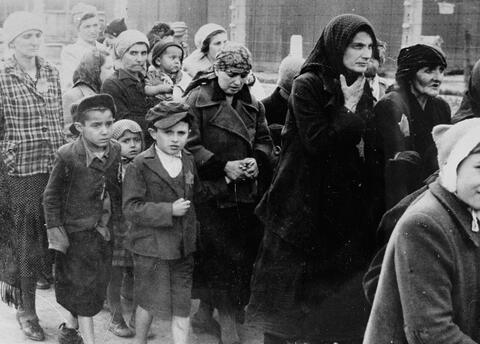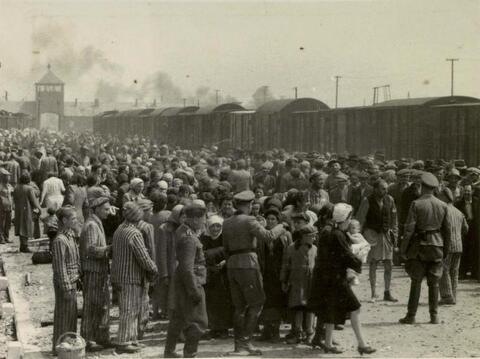Auschwitz
At a Glance
Language
English — USSubject
- History
- The Holocaust
In 1940, the Nazis built a camp called Auschwitz, located about 37 miles west of Kraków, Poland, to imprison Soviet prisoners of war and Polish resisters. In October 1941, the Nazis built a second camp there, known as Auschwitz II, or Auschwitz-Birkenau. With four large crematoria (including gas chambers and ovens to cremate victims’ bodies), Auschwitz-Birkenau became the largest of the killing centers built by the Nazis. Jews from all over Europe were sent to Auschwitz to be murdered. Some have said that the system of killing there resembled an industrial production line, but at Auschwitz, the goal of the process was not the production of goods but the deaths of millions of people.
The process began when Jews were ordered out of the trains that brought them to the death camp and made to stand in line for the “selection,” in which a Nazi doctor or other official would quickly decide which prisoners could serve as slave laborers and which would be killed right away. Small children and women with children were not considered for labor and automatically selected to be killed. Those not selected for labor were told that they would first undress and go into a special room for a shower and disinfection, after which they would be given food and new clothing. In reality, the shower rooms were gas chambers.
Women and Children at Auschwitz-Birkenau

Women and Children at Auschwitz-Birkenau
Jewish women and children from Subcarpathian Rus, a region of Ukraine, who have been selected for death at Auschwitz-Birkenau, walk toward the gas chambers.
Those pictured include Jolan Wollstein of Szombathely, her children Erwin, Judith, Dori and Naomi, her non-Jewish governess Edith, Henchu Mueller Falkovics, Kreindel Vogel and her sister Sase Vogel and Rita Gruenglass.
Some Jews were deliberately kept alive to assist with the killing process. Formed into Sonderkommandos, or special detachments, they were the ones who told the new arrivals to undress and then led them to the “shower room.” The Sonderkommandos were under strict orders to say nothing to the victims about what really awaited them. After the poison gas was released into the chambers and everyone inside was dead, the Sonderkommandos removed the bodies and transported them to specially built crematoria to be burned. Every few months, the Sonderkommandos were themselves murdered and replaced by a new group of prisoners.
One of the few members of the Sonderkommandos who survived Auschwitz described the killing site:
It was surrounded with a fence of sorts, made from piles of logs, two meters high, so you wouldn’t notice a thing from the outside. Around the crematorium was an electric fence. There was an entrance that led to a large yard. The yard was about twenty meters long and it led to the building where the furnaces were. We led the victims to the left side, where there were stairs, and then down to the undressing hall. Over the undressing hall [and gas chamber] there was no other floor. There were just four openings through which the SS men threw in the gas in order to kill the people. To keep air from coming in, they would close the lids above the openings. . . . Next to the corner of the undressing hall and the gas chamber, there were two floors—the furnaces downstairs and the living quarters [for the Sonderkommando] upstairs. A tall chimney, at least twenty meters high, rose from the roof of the building. The smoke billowed through it. . . . [The building] looked like an ordinary factory. There was nothing unusual about it. A simple building. 1
- 1Gideon Greif, We Wept Without Tears: Testimonies of the Jewish Sonderkommando from Auschwitz (New Haven, CT: Yale University Press, 2005), 95.
Hungarian Jews at Auschwitz

Hungarian Jews at Auschwitz
Hungarian Jews arrive at Auschwitz in 1944. More than 400,000 Jews from Hungary were deported to Auschwitz that year.
Another former Sonderkommando member described the killing process, beginning with the undressing hall:
The people walked into the room and once they were all inside they began to undress. . . . From the undressing room the people went down a narrow corridor to the gas chamber. At the entrance, there was a sign: “To the Disinfection Room.” . . . [T]he men waited naked until the women were in the gas chamber, and then they went in. . . . When a large transport with lots of people came, the people were beaten to force them to enter the room. . . . Only when they were already in the gas chamber did they sense that something was out of whack. When the gas chamber filled up, the Germans stood at the door with dogs and continued to pack the people in so that more than were already inside could be gassed. Those who hadn’t gone in yet began to shout. The Germans responded with murderous beatings. The people were already naked and defenseless, so they were pushed in by force. . . . The moment the gas chamber filled up the SS man closed the door. Right after that, SS men drove over in a car that carried the emblem of the Red Cross. The cans of gas were taken out of the car, opened, and their contents were thrown into the gas chambers through the opening of the wall. . . . Some time later, the SS doctor determined the death of the people in the chamber by saying “It’s all over.” Then he drove away in the “Red Cross” car. 1
As historians and survivors have struggled to describe and understand the nature of death camps like Auschwitz, they have also emphasized the near impossibility of conveying what it was like to people who were not there. Historian Gideon Greif, who edited a book of Sonderkommando accounts, writes:
Many former prisoners explained in their testimonies that everyday life in the Nazi camps was based on a total reversal of all moral standards. Power was associated solely with the license to oppress and torture. Values such as mercy and compassion were regarded as extreme, negative and perverse. . . . It gave rise to an upside-down world or, as the writer and Auschwitz survivor K. Tzetnik put it, “another planet,” a place that functioned on different, unknown principles. . . . Auschwitz constituted a reality that had never before existed and had never been known, let alone experienced. 2
Connection Questions
- Reading about the details of murder in the Holocaust requires us to slow down in order to try to understand the magnitude of this atrocity. After reading this account, take a few minutes to process your thinking about this history and human behavior by writing in a journal or elsewhere.
- Scholars often refer to the Nazi killing centers as places of “industrialized murder.” What does that mean? How was the method of murder in killing centers like Auschwitz “industrial”?
- How do the prisoners quoted in this reading describe the process of killing at Auschwitz? Who was involved in the killing? Why do you think the Nazis forced other prisoners (the Sonderkommandos) to assist in the murders? Why were Sonderkommandos killed and replaced every few months?
- Killing at the camps was different from the mass shootings perpetrated by the Einsatzgruppen. How did the new use of gas chambers change the distance between perpetrator and victim? What effect might this distance have had on the perpetrators?
How to Cite This Reading
Facing History & Ourselves, "Auschwitz," last updated August 2, 2016.








